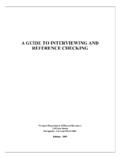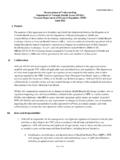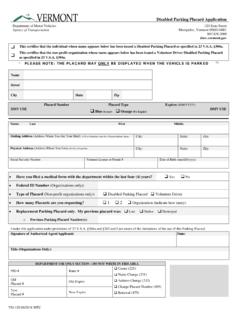Transcription of Guidelines for the Design of Stream/Road …
1 Guidelines for the Design of Stream/Road Crossings for Passage of aquatic organisms in VermontKozmo Ken Bates, , Kozmo, Kirn, vermont department of Fish and WildlifeMarch, 2009 _____ Guidelines for the Design of Stream/Road Crossings for Passage of aquatic organisms in vermont March, 2009 Guidelines for the Design of Stream/Road Crossings for Passage of aquatic organisms in vermont STATEMENT OF PURPOSE This document is intended to provide technical guidance in the Design and construction of Stream/Road crossings where the need for passage of aquatic organism passage has been identified. This guide is neither a cookbook nor a manual. Each site is unique, and conditions will lead to individual solutions. The methods and analyses described here are more rigorous than is necessary for simple sites and experienced Design teams will be able to streamline the process in many cases.
2 Many sites however have unique challenges that can only be solved by applying an in-depth understanding of the biological, hydrologic, geomorphic, and structural components of the Design . We therefore encourage that an interdisciplinary team approach be used for these designs. To be successful, it is important to recognize where this higher degree of rigor is needed and to bring in specialists when appropriate. These Guidelines are not intended for use as a regulatory document. They are informative and do not impose any legal or regulatory requirement on the owner/designer of the project. PREFACE Stream crossings by transportation systems have had a profound influence on the movement and distribution of populations of aquatic species in vermont . These impacts range from exclusion of species from tributaries of the White River and Connecticut River associated with the development of railroads and the interstate highway system, to highly fragmented habitats associated with town and private road development adjacent to stream networks.
3 vermont s Wildlife Action Plan ( vermont department of Fish and Wildlife, 2005) identifies a large number of aquatic species threatened by such habitat fragmentation including 15 species of greatest conservation need. The vermont department of Fish and Wildlife (VDFW) and the vermont Transportation Agency (VTrans) have formally recognized this threat in a 2005 Memorandum of Agreement. The agencies developed a common goal to improve accommodation of wildlife and aquatic organism movement around and through transportation systems and to minimize habitat fragmentation resulting from the presence of transportation infrastructure . The Guidelines for the Design of Stream/Road Crossings for Passage of aquatic Organism in vermont was developed by VDFW in collaboration with the vermont department of Environmental Conservation and VTrans as a major step toward meeting this goal. The contents of this guideline are based upon current knowledge of aquatic biology, fluvial geomorphology, hydrology and engineering and required the assistance of many experts in these areas of study.
4 This document is presented with the intent of fostering improved Design , installation, and maintenance of stream crossing structures to provide aquatic organism passage (AOP), aquatic habitat connectivity, and fluvial geomorphic functions in vermont streams and rivers. ACKNOWLEDGEMENTS: This guideline was produced with the assistance of many individuals. These efforts are greatly appreciated: Shayne Jaquith and Pat Ross of the vermont department of Environmental Conservation, River Management Program; Staff of the vermont Agency of Transportation; Ken Cox, Len Gerardi, Chet MacKenzie, Bernie Pientka and Christa Alexander of the vermont department of Fish and Wildlife. Neil Kamman and Jeff Cueto of the vermont department of Environmental Conservation provided valuable assistance in the development and analysis of the vermont hydrologic dataset. Funding: Funding of this project was provided by the vermont Fish & Wildlife department under the State Wildlife Grant Program and by fishing license sales and matching Dingell-Johnson/Wallop-Breaux funds, available through the Federal Sport Fish Restoration Act.
5 Mission Statement The mission of the vermont Fish and Wildlife department is the conservation of all species of fish, wildlife, and plants and their habitats for the people of vermont . To accomplish this mission, the integrity, diversity, and vitality of their natural systems must be protected. _____ Guidelines for the Design of Stream/Road Crossings for Passage of aquatic organisms in vermont March, 2009 _____ Guidelines for the Design of Stream/Road Crossings for Passage of aquatic organisms in vermont March, 2009 Guidelines for the Design of Stream/Road Crossings for Passage of aquatic organisms in vermont Table of Contents 1. 1-1 2. ECOLOGICAL ISSUES OF ROAD-STREAM CROSSINGS.
6 2-1 PASSAGE OF FISH AND OTHER aquatic ECOLOGICAL DIRECT LOSS OF aquatic WATER QUALITY UPSTREAM AND DOWNSTREAM CHANNEL CHANNEL CONSTRUCTION RISK OF STRUCTURE 3. Culvert 3-1 aquatic RESOURCE PRE- Design SITE Pre- Design Assessment Data ..3-2 Pre- Design Assessment Pre- Design Assessment Products ..3-4 PROJECT Alignment ..3-7 Culvert length ..3-8 Skewed and bend alignments ..3-8 Transitions ..3-10 PROJECT PROFILE Channel vertical adjustment range ..3-11 Scale of the General procedure for profile Design in a stable channel ..3-12 Incised or incising Headcut issues ..3-16 Aggraded or aggrading channels ..3-17 _____ Guidelines for the Design of Stream/Road Crossings for Passage of aquatic organisms in vermont March, 2009 4. Design FOR PASSAGE OF FISH AND OTHER aquatic organisms .
7 4-1 5. vermont Low-Slope 5-1 DEFINITION OF LOW-SLOPE LOW-SLOPE LOW-SLOPE Design Low-slope culvert size and Low-slope culvert bed ..5-3 6. Stream Simulation 6-4 DEFINITION OF STREAM SIMULATION Design STREAM SIMULATION STREAM SIMULATION Design STREAM SIMULATION SITE ASSESSMENT REFERENCE STREAMBED SPECIAL CONSIDERATIONS FOR OTHER CHANNEL CROSSING STRUCTURE SHAPE, DIMENSIONS, AND CULVERT CULVERT INVERT ELEVATION AND BED MOBILITY AND STABILITY 7. Hydraulic Design .. 7-1 DEFINITION OF HYDRAULIC Design HYDRAULIC HYDRAULIC Design Hydraulic Design Site Assessment Needs ..7-3 Length of Culvert ..7-3 Biological Design ..7-3 Hydrology ..7-5 Hydraulic Criteria; Velocity, Jump Height, Depth, and Summary of Hydraulic Design 8. Alternative Designs .. 8-1 9. Profile Control .. 9-1 CHANNEL BOULDER ROUGHENED _____ Guidelines for the Design of Stream/Road Crossings for Passage of aquatic organisms in vermont March, 2009 RIGID 10.
8 Final Design .. 10-4 CULVERT SHAPE, STYLE, AND HYDRAULIC Design 11. References Cited .. 11-1 Appendix A - Glossary Appendix C - Baffles for Hydraulic Designs Appendix D - Culvert Design Data Summary Form Appendix E - Instream Construction Periods Appendix F - Existing Regulations and Recommended Practices _____ Guidelines for the Design of Stream/Road Crossings for Passage of aquatic organisms in vermont March, 2009 1. INTRODUCTION There are numerous barriers to the movement of fish and other aquatic organisms in streams and rivers in vermont . Though some of these barriers occur naturally, such as bedrock falls, many, such as culverts and dams, are human-created. Culverts in particular are a daunting challenge; there are thousands of them in vermont s landscape and more are being installed every year as vermont continues to develop.
9 A study by the vermont department of Fish and Wildlife of culverts throughout the state provides some sobering results. Of 465 culverts assessed, less than 2% were rated as fully passable by aquatic organisms (Milone and MacBroom 2009). VDFW presents these Guidelines with the intent of fostering improved Design , installation, and maintenance of stream crossing structures to provide and maintain aquatic organism passage (AOP), aquatic habitat connectivity, and fluvial geomorphic functions in vermont waters. This document provides concepts, Design framework, and procedures to Design road-stream crossings that satisfy ecological objectives including the passage of fish and other aquatic organisms . These Guidelines are not meant to replace existing standards and do not include all of the information necessary for a complete Design of a stream crossing. The designer should refer to other documents, standards and experts for structural, roadway, geotechnical, and other engineering and environmental considerations associated with the Design .
10 Passage of fish and aquatic organisms at road crossings is a complex issue. We strongly encourage that an interdisciplinary team approach be used for these designs. There are technical issues that should be considered by a range of expertise including biological, engineering, geomorphologic, geotechnical, structural, and hydrologic. We also encourage the Design team to consult with VDFW Fisheries Biologists early in the project planning to ensure project objectives and biological considerations are appropriately defined. Regulatory Obligations These Guidelines are not intended for use as a regulatory document, but as technical guidance for the Design road-stream crossings where aquatic organism passage needs have been identified. There are several existing state and federal regulations that address the passage of fish and aquatic organisms in vermont : Army Corps of Engineers, vermont General Permit Condition #17: Waterway Crossings Clean Water Act National Roads Exemption BMP 40 CFR c(6) 10: Conservation and Development Chapter 41: Regulation Of Stream Flow Chapter 111.






